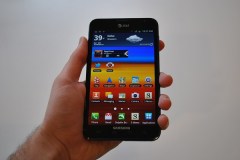Thanks to an over-the-top Super Bowl ad, millions of people have heard of Samsung’s Galaxy Note smartphone — but for the wrong reason.
Although the Galaxy Note’s stylus was the focus of the commercial, the real showstopper — and the main reason I wanted to write a review — is the phone’s 5.3-inch screen, which practically qualifies the Note as a tablet.
(MORE: Note to Samsung: The Pen Doesn’t Sell)
Mostly, I was curious to know if the Galaxy Note made sense in the real world, not just at the Consumer Electronics Show, where I was first mesmerized by that giant, 720p AMOLED display. Could anyone actually live with this thing?
The short answer is yes.
I know this early on because my wife loved it. Her actual words were “Yeah, this is pretty awesome,” which she never says about any of the gadgets that show up at our house for review. That, to me, is proof enough that the niche exists for 5-inch phone-tablet hybrids.
(MORE: Two Minute Video: Samsung’s 5.3-inch Galaxy Note – Phone or Tablet?)
Now for the long answer:
The Galaxy Note, which AT&T sells for $300 on contract, is a phone of trade-offs. You will not be able to use this phone with one hand, save for the occasional swipe through your Facebook feed. Your fingers just won’t have the reach. In return, you get a handheld device that doesn’t feel cramped. Each home screen allows for a 5-by-5 grid of icons, instead of the 4-by-4 arrangement on most phones. Web pages remain legible even when fully zoomed out, so you may never have to rely on another mediocre mobile-optimized website.
 You’ll also look a little silly making phone calls, holding the humongous Galaxy Note up to your ear. The phone will look and feel large in your pants pocket. Some Apple snobs might laugh at you. But then, wielding the Note brings a feeling of power. Other phones — even large ones with 4.5-inch displays — suddenly seem puny. Sometimes I hoped people would flag me down to ask about the device, as in the commercial. (Didn’t happen.)
You’ll also look a little silly making phone calls, holding the humongous Galaxy Note up to your ear. The phone will look and feel large in your pants pocket. Some Apple snobs might laugh at you. But then, wielding the Note brings a feeling of power. Other phones — even large ones with 4.5-inch displays — suddenly seem puny. Sometimes I hoped people would flag me down to ask about the device, as in the commercial. (Didn’t happen.)
It helps that the Galaxy Note cuts a slim figure, with gently curved lines that feel right in the hand, and the faux-metal trim around the edges of the device makes a sharp but welcome contrast with the cross-hatched, removable back cover. The concept might not have worked if the device was ugly.
(MORE: Samsung’s 5.3-inch Galaxy Note: Giant Phone Meets Tiny Tablet)
As I dug into the software, though, the experience started to fray. Count me as a fan of Samsung’s TouchWiz interface, which on my Galaxy S II lends a smooth polish to the sometimes jerky Android 2.3. Yet stutters and slowdowns abound on the Galaxy Note, which runs nearly the same software as the Galaxy S II, yet on a slightly faster 1.5 GHz dual-core processor.
The home screen and built-in apps are still pretty fluid, but third-party apps fare worse. Twitter crawled beneath my finger, and Dolphin Mini — my third-party browser of choice — wasn’t immune to choppiness. Again, on my Galaxy S II, this isn’t a problem. The Note’s inability to deliver the same software performance is a big letdown.
 The stylus proved to be a neat party trick — especially with the Note’s ability to translate handwriting into text — but I never figured out how to make the so-called S-Pen practical. Input is too laggy to take accurate written notes, and the screen wasn’t big enough for me to draw or write with ease. I’d love to see Samsung work on the lag issue and include a pen in one of its 7-inch tablets, but on the Note, it still feels like a gimmick at worst or a fringe feature at best.
The stylus proved to be a neat party trick — especially with the Note’s ability to translate handwriting into text — but I never figured out how to make the so-called S-Pen practical. Input is too laggy to take accurate written notes, and the screen wasn’t big enough for me to draw or write with ease. I’d love to see Samsung work on the lag issue and include a pen in one of its 7-inch tablets, but on the Note, it still feels like a gimmick at worst or a fringe feature at best.
Although I feared that the Galaxy Note’s large screen would be a battery killer, Samsung fights back with a 2,500 mAh battery. I didn’t do rigorous testing, as with the Motorola Droid Razr Maxx, but after 48 hours off the charger and light to moderate use, the Galaxy Note still had a little juice left. There’s no AT&T 4G LTE in my area, but my editor, Doug Aamoth, tested the Note in Boston, and said the battery held up decently on the faster connection.
For Samsung, advertising the Galaxy Note with a 90-second Super Bowl commercial was a gamble. The average 30-second Super Bowl ad cost $3.5 million according to Bloomberg, which means Samsung might have spent more than $10 million to get the word out about a niche product. But it’s a niche product that I like, despite its awkwardness and its faults. Here’s hoping the big bet pays off, and the phone-tablet hybrid lives on.
(MORE: The Future Smartphones of 2012)

